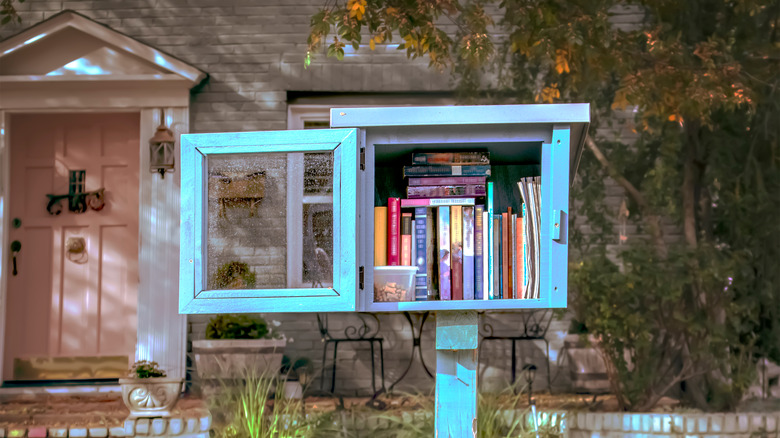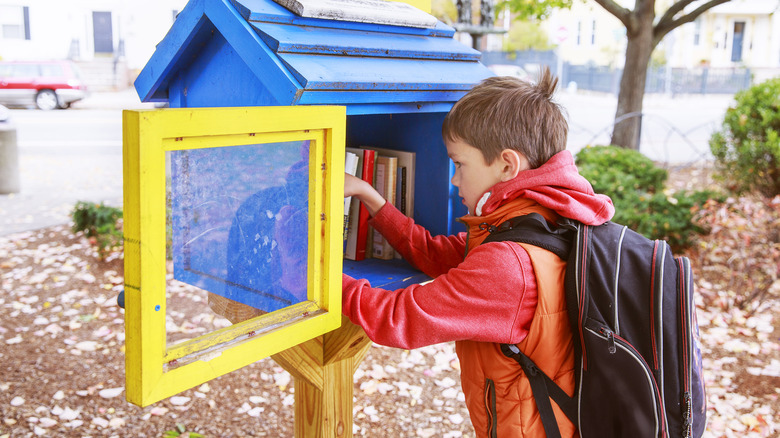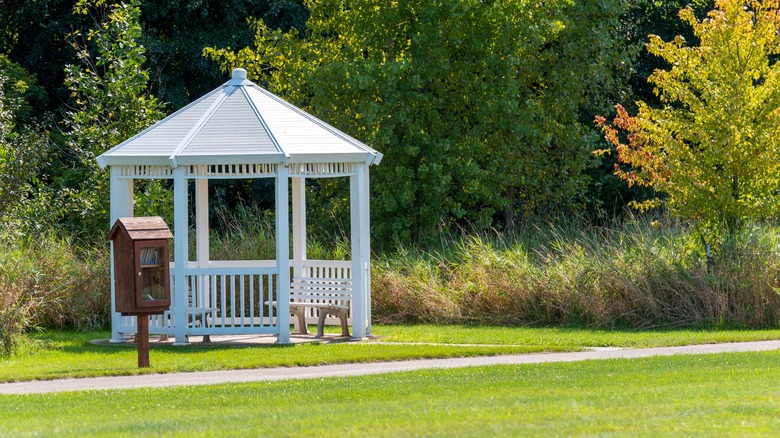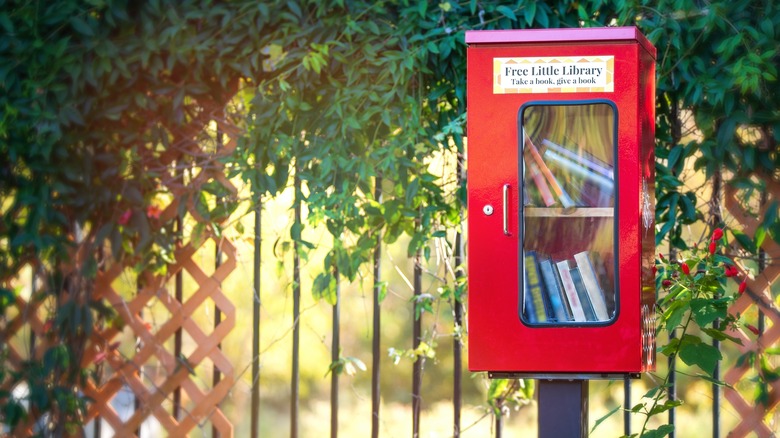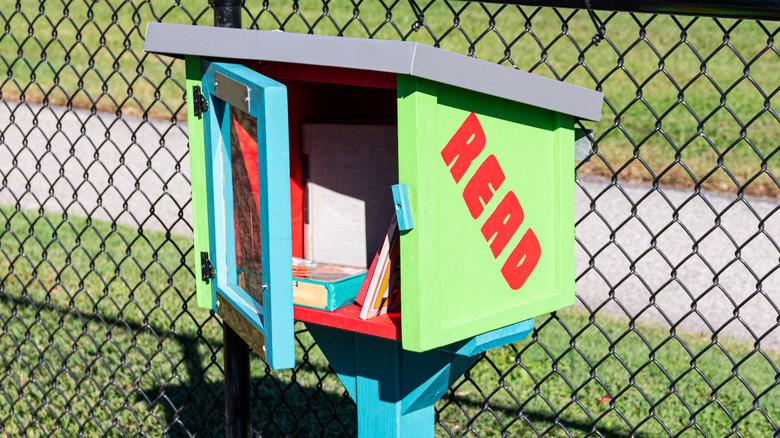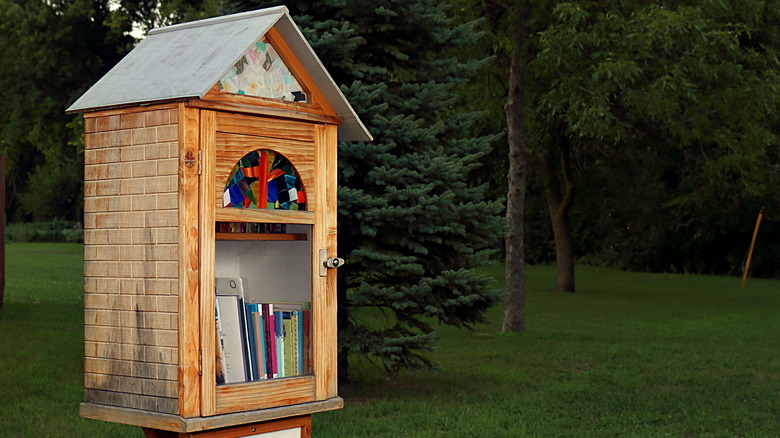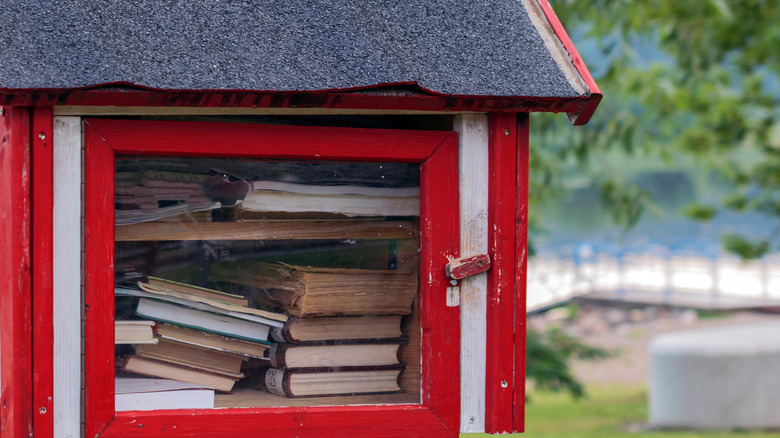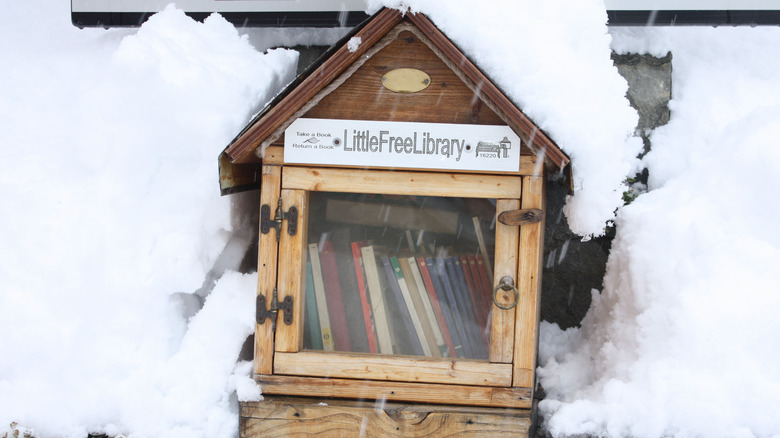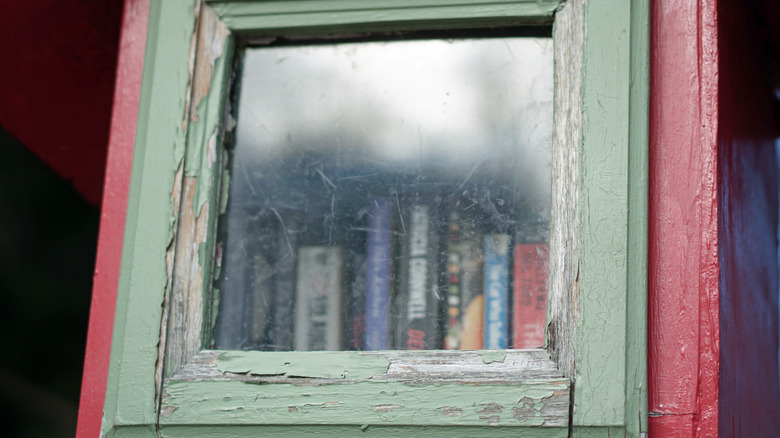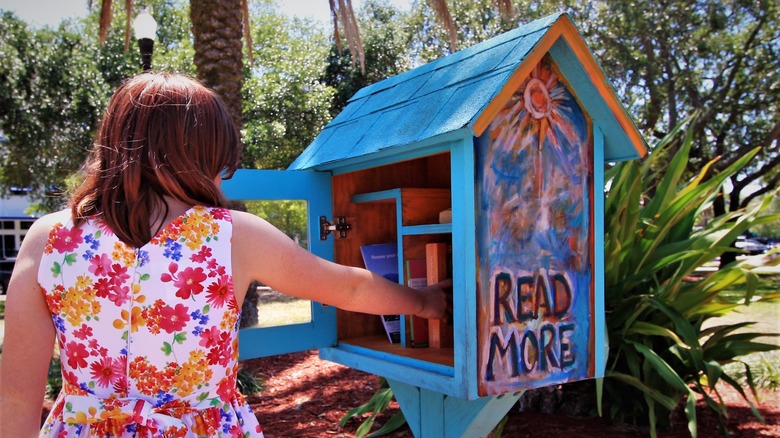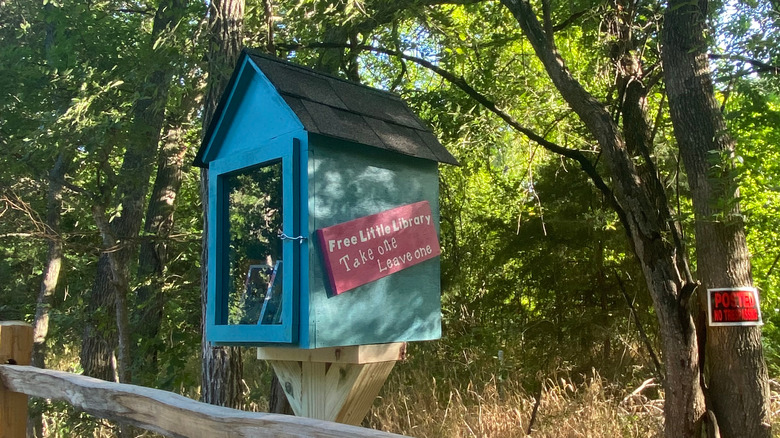What You Need To Know About Installing A Little Free Library
You may have seen a Little Free Library in towns you visit or know of them through the grapevine. They're those wooden structures, often shaped to look like a little house or barn, that house a small collection of books. This non-profit organization started in St. Paul, Minnesota, in an effort to make reading more accessible in communities across the globe. In fact, according to its website, as of today, there are over 150,000 Little Free Libraries.
The best part about its mission is anyone can choose to set one up. And some areas can have more than one. In Detroit, there are an estimated 500 libraries, as reported by American Libraries Magazine. Installing a Little Free Library starts with a desire to spread the love of reading. But it also requires some prep work and dedication. If you're interested in bringing one into your town, here are some key things you need to know about installing one.
You need to determine if there is a need
One of the first things you should do is determine if there is a need for a Little Free Library in your town. While it's always a good idea to make books more accessible, if your town is small and the local library is within quick driving or walking distance to most people, installing one may not be worth it. During the pandemic, Little Free Libraries popped up more frequently due to bookstores and libraries being shut down.
People were even installing them on their properties, like one woman from Oradell, New Jersey. According to Reason, she wanted to bring her community together through a shared love of reading, and this was the best way she knew how. One way to determine if there is a need is to go around town and ask. Do neighbors feel the library is too far or doesn't offer enough of a selection? Take to social media and put out a poll or go to a local town meeting. This way, you'll be in a better position to determine if there is a need for one in your town.
You need to choose the best location
Location matters a lot when you're looking to install a Little Free Library. You don't want it out of the way where no one will ever see it, and you don't want it in a place that will cause traffic and unnecessary delays. The best practice is to install the library in a high-traffic area with plenty of space, so it's not overlooked. A local park or on a main drag are two excellent locations. You may also want to put one near a school or coffee shop. Others are located at bus stops and train stations. The limits are truly endless.
You can also consider putting one in your own front yard. This may not work if you have a low-trafficked block, but if your street is long or is a main throughway, it can be a great location for a Little Free Library. In fact, you can reap many benefits by installing one on your property, as Art of Manliness notes. Not only are you promoting literacy, but it gives you a chance to talk to neighbors you may otherwise ignore. The books people leave will open you up to new authors, and it showcases your generous nature. So when deciding on a location, don't rule out your yard, though it's one option of many.
You need to know your town's zoning laws
Whether you install the Little Free Library in your yard or somewhere in town, you need to do some prep work and learn your town's zoning laws. Skipping this part might get your library shut down or even removed, and that's the last thing you want. These statutes differ from state to state and town to town. That's why it's important to contact your local zoning department and tell them what you plan on doing.
For the most part, towns are happy to see Little Free Libraries built, but to avoid complaints and possible penalties, know what you can and cannot do. For example, you might need to know how tall your library can be. According to Lit Hub, a New Jersey woman was asked to lower her Little Free Library to below four feet tall, claiming it violated a local ordinance. She didn't have to in the end, but save yourself the hassle of zoning issues by knowing exactly what your town allows. You might need a Right-of-Way permit to build one, or you might need to call the 811 "Call Before You Dig" number to ensure there are no sewer or electric pipes underneath your intended spot. Some counties see them as a "detached structure," much like a shed or garage, and need to grant permission to build them. Others consider it an accessory use, and have specific rules on where it can be placed and how big it can be. Luckily, after a phone call or a few email exchanges, you should be good to go.
You need to figure out what box you want
There are a lot of decisions when it comes to installing a Little Free Library, and another one is deciding what box you want. The size you go for may depend on your town's zoning laws, but the good news is there are options. For starters, the Little Free Library website offers different size boxes for you. You can choose one with a single door, two doors, and even shop accessories. The box arrives unfinished so you can paint and stain it in whatever colors you desire.
Your second option is to build a box from scratch. This is definitely the better choice for those who love a good DIY project and are good with basic structural foundations. The supplies you need will vary, but for the most part, At Home With Ashley recommends having plywood, shingles, roof nails, caulk, plexiglass, and hinges to start. You can be as creative or simple with the design as you'd like, though you want to make it alluring to those passing by.
You need to decide whether to go solo or work with a group
As you begin to prepare your installation, you'll also want to decide if you're going to tackle this alone or work with a group. Both have their pros and cons, though the pros outweigh the cons. For example, going at it alone means you don't need to worry about anyone else's opinions about the look and color of the box. You can build it to your own specifications, and installation will go quickly. However, going at it solo means you're responsible for the upkeep and general maintenance.
Working with a group can be a fun team-building activity and is a great way to get students involved. In fact, the Boys & Girls Club of America created what they call the "Blue Roof Library Trail," which is a stretch of 30 Little Free Libraries they built in Mobile, Alabama. Not only did they work together to determine where the libraries would go, but installing them increased their teamwork and creative abilities. So if you feel this project might be better suited for your children's cub scout group or your own book club, mention it and see what happens.
You need to have books ready to go
It's important not to always rely on others to fill the library for you. If you plan to install a Little Free Library, make sure you have a few books ready. Do you need enough to fill the library? No, because you want to encourage others to leave books, and the display won't be alluring if it's too cramped. But you need to have a few ready for when installation is complete. A Little Free Library without books won't appeal to many people.
What are some ways you can ensure you have books ready? First, browse your own shelves and see if there are any you want to discard. Ask your family for donations and even friends. According to Book Riot, your local library is another great venue. Check to see if they're looking to get rid of certain books and add them to your library. Once you promote your library, you'll be amazed at how quickly it fills up. But have at least 10 to 15 books ready to go for when you're done installing it.
You need to register your library online
Little Free Libraries are so well known that people actively seek them out when traveling, and the non-profit's website has made that easier by having a running list of all active locations. You can find libraries all over the globe using its search function. That means if you want yours on that list, you need to register your library with the organization. This is important because it will attract more readers to your location, which increases foot traffic. And the more foot traffic you have to your library, the more successful it will be.
If you buy a box from the Little Free Library, it'll automatically come with a charter sign that includes the number you need to register your library. If you build one on your own, you can buy a charter sign from the website for $39.95. According to Kristina Hunter Flourishing, registering your Little Free Library helps build a network of support and can earn you some media coverage. While most Little Free Libraries are stumbled upon by accident, registering it will give you a better chance of being found, seen, and shared.
You need to weatherproof your library
The longevity of your box depends on the care and attention you give when installing it. That means deciding whether you want to weatherproof your library or not. This really depends on where you live and the type of weather your area gets all year round, though it doesn't hurt to weatherproof it regardless of locale. The location of your box may also help you decide what type of weatherproofing you'll need to give it.
According to Epoxyworks, weatherproofing not only ensures the box itself lasts longer but also protects the books inside. The last thing you want is rain leaking from the roof and destroying the books. That's why it suggests using a strong moisture barrier as a base. You'll also want to use strong exterior paint that won't chip after one rainstorm. Don't forget to weatherproof the pole as well to avoid rust and unnecessary replacements.
It takes regular upkeep
We mentioned earlier how installing a Little Free Library on your own means being solely responsible for the general upkeep. Remember that the box is exposed to outdoor elements 24/7 so it will get some damage at some point. But if you schedule regular check-ins, you'll be able to stop things from worsening. Little Free Library recommends repainting your box every one to two years. You'll also want to sand down any splinters and fix any roof shingles that may have come loose.
The damage your box may get will vary depending on its location and the type of weather you get throughout the year. For example, strong winds may throw items against the box and chip or break the glass. If that happens, replace the plexiglass as soon as possible. You can learn how with this helpful YouTube video. Do your best to check the status of your box after big storms, though it's always a good idea to give it a routine check once a month. The minute you see some damage, plan to repair it so it doesn't get worse.
You need to rotate the books every few weeks
One way to keep your library fresh and appealing is to schedule a book rotation every two or three weeks. Just like there are new books published every week, you want to keep the titles in your library ever-changing. This way, you entice readers to come back to see what's new. This is especially important if you notice people borrowing books rather than leaving some. According to Life With Less Mess, something you can do to make the book rotation a little more exciting is to come up with themes.
For example, as it gets closer to the holidays, try to include books that are themed for that time. In the summer, focus on displaying "beach reads" and keep titles spooky during Halloween. Themed books give people a little less decision fatigue, and it helps you know what books should go in next. Creating book themes is not necessary, but it can make doing a bi-weekly book rotation easier. Still, whether you do themes or not, it's important to swap out the books every few weeks.
You need to market your library for success
There are a few ways people will find your Little Free Library. Most will find it by accident, some will find it on the central website's registered list, and others will learn about it through marketing. If you truly want your library to be successful, you need to spend some time marketing it. In today's social media age, that is easier than ever.
Little Free Library offers a few tips. You can reach out to local TV stations and newspapers to get coverage. You can also make flyers and hang them up at nearby supermarkets, churches, and businesses. Book Riot also suggests creating social media accounts specifically for your Little Free Library. You can share when new books are added or reach out to followers for specific titles. You can even start a website or email list dedicated to it and share fun book news or special themes you have going on. The more you market, the better your library will do, and the more you'll spread the love of reading around your town.
